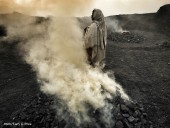2016 Photo Gallery
Images may be downloaded for use in relationship to the 2016 report The World's Worst Pollution Problems 2016: The Toxics Beneath Our Feet only. Please credit images as noted in captions. For permission to use photos by Larry C. Price, please email debbie@priceandpricecreative.com
A young man stands barefoot on land next to his farm in Sheikpura village on the outskirts of the city of Kanpur in India. Beneath his feet, contaminated water pours out sewerage pipes and enters his farm.
Photo: Sean Gallagher
A woman tends fires of burning coal at a village outside Djaria, India, the epicenter of the country’s largest coal deposits. Villagers scavenge coal from the bottom of nearby open pit mines, burn the coal pieces to form charcoal, then sell bags of the processed coal in local markets.
Photo: Larry C. Price
Toxic chromium compounds from an abandoned chemical factory in Ranipet, India, leach into the watershed. The factory produced chromium-based chemicals used in the leather tanning industry. This chromium waste accumulated in massive mounds on the factory grounds, where it remains today, more than 20 years after the plant closed 1995.
Photo: Larry C. Price
A woman in Indonesia breaks up lead slag left over from the recycling of used lead-acid batteries
Photo: Pure Earth
A man in Tegal, Indonesia, uses a hammer to break up old batteries by hand in order to extract the valuable lead within. The improper recycling of used lead-acid batteries takes place in almost every low- and middle-income country, sometimes in backyards and kitchens. Toxic lead is spilled everywhere in the process.
Photo: Larry C. Price
In Kebasen, Indonesia, three new battery smelters process thousands of batteries a day. The workers each sit on a battery casing on the floor and swing small axes to split open the batteries and remove the lead cells. Other workers shovel the cells into the furnaces. After the lead melts, they pour it into trays to make ingots. The lead is bought by a company that makes fishing weights and air gun pellets.
Photo: Larry C. Price
In the Vellore district of Tamil Nadu, women arrive at the tanneries early in the morning wearing jewelry and brightly colored saris, as though they were going to a shop or restaurant, certainly not to a place where they are constantly splattered with rotting animal flesh. They wrap themselves in plastic to protect their clothes, some pull on gloves, and then they go to work. Some stand or sit for hours, plucking hair by hand from softened hides stretched over frames. Others stir sheets of leather floating in vats of chemicals.
Photo: Larry C. Price
Waste water and sludge collect near an industrial estate in India
Credit: Pure Earth
Obsolete pesticides are often left in abandoned buildings and stored in crumbling barrels. At this location in the former Soviet Union, workers in hazmat suits are working to ensure that the toxic substances are safely managed.
Photo: Pure Earth
Man taking air samples at the Agbogbloshie e-waste site in Ghana. Informal recyclers burn e-waste to extract valuable metals. The burning releases toxic fumes that contaminate the community.
Photo: Pure Earth
One of the local Pure Earth remediation crews that worked on the cleanup of lead contamination in the community of Chowa in Kabwe, Zambia. Almost every child in Chowa suffers from lead poisoning. The contamination comes from lead mines and smelters located just a short five-minute walk away from hundreds of homes.
Photo: Pure Earth
A man sprays pesticides on a field in the Punjab region of northwest India. Excessive pesticide use in the region over the past 30-40 years has led to the accumulation of dangerous levels of toxins such as uranium, lead and mercury, which are contributing to increased health problems in rural communities.
Photo: Sean Gallagher

































